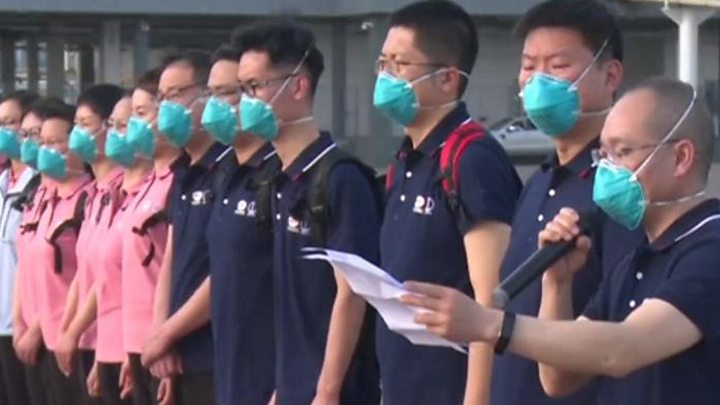Image copyright
AFP
An apparent surge in traffic outside Wuhan hospitals from August 2019 may suggest the coronavirus hit the area earlier than reported, a study says.
Harvard researchers say satellite images show an increase in traffic outside five hospitals in the city from late August to December.
The traffic spike coincided with a rise in online searches for information on symptoms like “cough” and “diarrhoea”.
China said the study was “ridiculous” and based on “superficial” information.
It is believed that the virus first appeared in China some time in November. Authorities reported a cluster of pneumonia cases with an unknown cause to the World Health Organization (WHO) on 31 December 2019.
“Clearly, there was some level of social disruption taking place well before what was previously identified as the start of the novel coronavirus pandemic”, Dr John Brownstein, who led the research, told ABC news.
The study has not been peer-reviewed.
What did the study show?
The researchers examined commercial satellite data from outside five Wuhan hospitals, comparing data from late summer and autumn 2018 to the same time period in 2019.
In once case, researchers counted 171 cars parked at one of Wuhan’s largest hospitals, Tianyou Hospital in October 2018.
Satellite data from the same time in 2019 showed 285 vehicles in the same place, an increase of 67%.
A surge in online searches for words associated with the symptoms of coronavirus on the Chinese search engine Baidu seemed to emerge at the same time.
“This is all about a growing body of information pointing to something taking place in Wuhan at the time,” Dr Brownstein told ABC.

Media playback is unsupported on your device
“Many studies are still needed to fully uncover what took place and for people to really learn about how these disease outbreaks unfold and emerge in populations. So this is just another point of evidence.”
Chinese Foreign Ministry spokeswoman Hua Chunying dismissed the findings at a press briefing on Tuesday.
“I think it is ridiculous, incredibly ridiculous, to come up with this conclusion based on superficial observations such as traffic volume,” she said.
What are the implications of the study?
The BBC’s John Sudworth in Beijing says there were limits on the data set used by researchers – for example, they could not always compare satellite images taken on the same day in consecutive years due to cloud cover in some of the photos.
But if the infection was present – undetected perhaps – some people could have been leaving Wuhan and travelling abroad and that fits with some of the other evidence we have begun to see in other parts of the world suggesting early cases of Covid-19, our correspondent says.
However it may be unfair to use the study as evidence of a cover-up or delay in China’s response, because with a previously unknown illness taking root in a community it is quite possible that there was some undetected spread before it was noticed officially, our correspondent adds.
Image copyright
Harvard University
The researchers studied and annotated satellite images showing Wuhan hospitals
China reported pneumonia cases with an unidentified cause to WHO on 31 December 2019.
Nine days later, Chinese authorities revealed they had detected a novel coronavirus (later named Sars-CoV-2, the virus causing Covid-19) in several of the pneumonia cases.
Wuhan and other Chinese cities went into lockdown on 23 January 2020.
The WHO declared Covid-19 a Public Health Emergency of Global Concern on 30 January 2020 – this followed 82 confirmed cases outside China.

